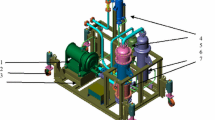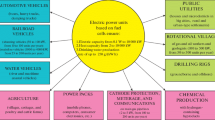Abstract
One of the main objectives of severe accident management at a nuclear power plant is to protect the integrity of the containment, for which the most serious threat is possible ignition of the generated hydrogen. There should be a monitoring system providing information support of NPP personnel, ensuring data on the current state of a containment gaseous environment and trends in its composition changes. Monitoring systems’ requisite characteristics definition issues are considered by the example of a particular power unit. Major characteristics important for proper information support are discussed. Some features of progression of severe accident scenarios at considered power unit are described and a possible influence of the hydrogen concentration monitoring system performance on the information support reliability in a severe accident is analyzed. The analysis results show that the following technical characteristics of the combustible gas monitoring systems are important for the proper information support of NPP personnel in the event of a severe accident at a nuclear power plant: measured parameters, measuring ranges and errors, update rate, minimum detectable concentration of combustible gas, monitoring reference points, environmental qualification parameters of the system components. For NPP power units with WWER-440/270 (230) type reactors, which have a relatively small containment volume, the update period for measurement results is a critical characteristic of the containment combustible gas monitoring system, and the choice of monitoring reference points should be focused not so much on the definition of places of possible hydrogen pockets but rather on the definition of places of a possible combustible mixture formation. It may be necessary for the above-mentioned power units to include in the emergency operating procedures measures aimed at a timely heat removal reduction from the containment environment if there are signs of a severe accident phase approaching to prevent a combustible mixture formation in the containment.
Similar content being viewed by others
References
Mitigation of Hydrogen Hazards in Severe Accidents in Nuclear Power Plants, IAEA TECDOC No. 1661 (Int. At. Energy Agency, Vienna, 2011).
R. K. Kumar and G. W. Koroll, Carbon Monoxide–Hydrogen Combustion Characteristics in Severe Accident Containment Conditions (Nucl. Energy Agency, Paris, 2000).
V. V. Bezlepkin, S. E. Semashko, S. V. Svetlov, V. G. Sidorov, I. M. Ivkov, Yu. Yu. Petrov, V. O. Kukhtevich, Yu. V. Krylov, and T. G. Vardanidze, “Activities for hydrogen explosion safety assurance for power units № 1, 2 of Kola NPP with VVER-440/230,” in Proc. 4th Int. Sci.-Tech. Conf. Safety Assurance of NPP with VVER, Podolsk, May 23–25, 2005 (Gidropress, Podolsk, 2005). http://www.gidropress.podolsk.ru/files/proceedings/mntk2005.
O. A. Oganesyan, “Studying the processes of hydrogen spread and combustion in sealed areas of VVER-400 power unit in the case of severe emergency,” Molodoi Uch., No. 13, 158–162 (2015).
Reference Datasheet “Multi-Functional Containment Atmosphere Monitoring System HERMETIS” (AREVA, 2012). http://de.areva.com/customer/liblocal/docs/KUNDENPORTAL/PRODUKTBROSCHUEREN/Brosch%C3%BCren%20nach%20Nummer/269-HERMETIS_en-Web.pdf.
NP-010-98. Rules of Design and Operation of Localizing Safety Systems of Nuclear Power Plants (Gosatomnadzor Rossii, Moscow, 1999).
NP-040-02. Rules of Hydrogen Explosion Safety Assurance at Power Plants (Gosatomnadzor Rossii, Moscow, 2002).
Author information
Authors and Affiliations
Corresponding author
Additional information
Original Russian Text © V.G. Petrosyan, E.A. Yeghoyan, A.D. Grigoryan, A.P. Petrosyan, M.R. Movsisyan, 2018, published in Teploenergetika.
Rights and permissions
About this article
Cite this article
Petrosyan, V.G., Yeghoyan, E.A., Grigoryan, A.D. et al. Characteristics of Hydrogen Monitoring Systems for Severe Accident Management at a Nuclear Power Plant. Therm. Eng. 65, 79–87 (2018). https://doi.org/10.1134/S0040601518020040
Received:
Accepted:
Published:
Issue Date:
DOI: https://doi.org/10.1134/S0040601518020040




